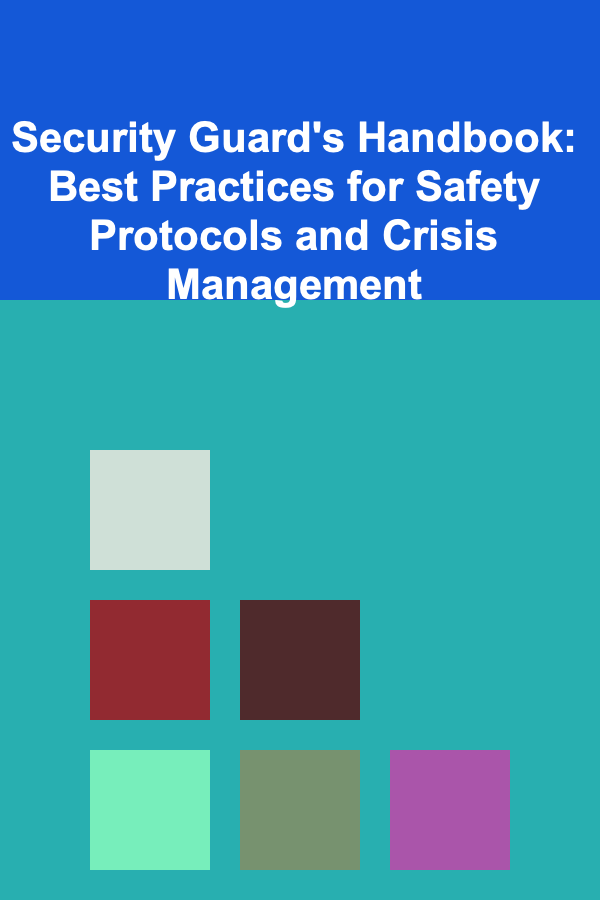
Security Guard's Handbook: Best Practices for Safety Protocols and Crisis Management
ebook include PDF & Audio bundle (Micro Guide)
$12.99$5.99
Limited Time Offer! Order within the next:

Security guards play an essential role in protecting people, property, and assets. They are often the first line of defense in maintaining a safe environment, whether at a commercial building, residential complex, hospital, school, or event venue. This comprehensive guide explores best practices for security guards to follow in safety protocols and crisis management, ensuring they can respond effectively and confidently during emergencies and routine operations.
Understanding the Core Responsibilities of a Security Guard
Before delving into safety protocols and crisis management, it's crucial to understand the core responsibilities of a security guard:
- Surveillance and Monitoring: Observing and monitoring the premises to prevent suspicious activity, theft, vandalism, or any other threats.
- Access Control: Managing access points and ensuring that only authorized individuals can enter restricted areas.
- Emergency Response: Acting quickly and effectively in case of emergencies like fires, medical incidents, or security breaches.
- Customer Service: Interacting with employees, visitors, and customers in a professional manner, providing information, and offering assistance when necessary.
- Report Writing: Documenting incidents, observations, and daily activities to ensure clear communication and accountability.
Understanding these duties sets the foundation for security guards to implement best practices and manage crisis situations efficiently.
Best Practices for Safety Protocols
The role of a security guard is centered on maintaining a safe environment. Adhering to established safety protocols ensures that security guards can prevent incidents before they occur, respond to threats quickly, and minimize risks.
2.1 Routine Safety Inspections
Security guards should conduct regular patrols and inspections of the premises. This proactive approach helps identify potential vulnerabilities such as unlocked doors, broken windows, malfunctioning security cameras, or any safety hazards.
Key Actions:
- Perform scheduled patrols, ensuring all areas are covered, including hidden or less frequented spots.
- Check fire exits, emergency lighting, and alarm systems to ensure they are functioning properly.
- Report any damaged equipment or structural issues immediately for repairs.
2.2 Clear Communication and Documentation
Effective communication is critical for maintaining security. Security guards must have established communication channels with other team members, supervisors, and emergency responders. In addition, documenting observations and incidents helps track patterns, monitor security efforts, and provide legal protection in case of disputes.
Key Actions:
- Use radios, cell phones, or other reliable devices to stay in constant contact with team members.
- Maintain detailed logs of patrols, incidents, or any unusual activities, noting the time, location, and actions taken.
- If using surveillance equipment, ensure cameras are positioned properly and functioning as intended. Report any failures promptly.
2.3 Ensuring Proper Training and Certification
Security guards should undergo continuous training to stay up-to-date with the latest security protocols, emergency response procedures, and technological advancements. Certification from recognized agencies not only ensures compliance with local regulations but also enhances the guard's ability to handle various scenarios effectively.
Key Actions:
- Attend training programs on first aid, fire safety, conflict resolution, and de-escalation techniques.
- Get certified in using security technologies, including alarm systems, CCTV monitoring, and access control systems.
- Stay informed on changes in security laws, privacy regulations, and workplace safety standards.
2.4 Adhering to Legal and Ethical Standards
Security guards must be aware of the legal and ethical standards governing their profession. This includes understanding the boundaries of their authority, respecting individuals' rights, and operating within the confines of the law.
Key Actions:
- Know the legal limitations of actions like searches, detainment, and use of force.
- Be transparent and non-discriminatory when performing duties, ensuring equal treatment for all individuals.
- If working in a specific industry (e.g., healthcare, education), understand the industry-specific legal requirements and regulations.
Crisis Management: Handling Emergencies and High-Risk Situations
Crisis management is an integral aspect of a security guard's job. In emergency situations, such as active shooter scenarios, fire outbreaks, or medical emergencies, security guards must act quickly, follow protocols, and work collaboratively with other emergency responders.
3.1 Assessing the Situation
During a crisis, the first step is to assess the situation. Security guards must remain calm and quickly evaluate the scope of the emergency. Understanding the nature of the threat helps determine the appropriate response, whether it involves evacuation, lockdown, or medical intervention.
Key Actions:
- Stay calm and focused to avoid making hasty decisions.
- Assess the severity of the situation by observing key factors such as the number of people involved, the location of the threat, and the potential risks.
- Identify escape routes, areas of refuge, and critical access points to ensure clear and effective actions.
3.2 Evacuation Protocols
In cases where evacuation is necessary, security guards must ensure that the process is swift and orderly. They must guide people to safe exits, assist those with disabilities, and ensure that no one is left behind.
Key Actions:
- Familiarize yourself with all evacuation routes and exits before an emergency occurs.
- Direct individuals to designated safe zones and ensure that the building is completely evacuated.
- If using fire alarms or emergency alerts, ensure they are activated promptly to warn others.
3.3 Active Shooter Protocols
In the event of an active shooter situation, time is of the essence. Security guards must be trained in proper response tactics to mitigate harm and protect the public.
Key Actions:
- Follow the "Run, Hide, Fight" principle:
- Run: Evacuate the building if possible and guide others to safety.
- Hide: If evacuation is not possible, find a secure hiding spot, lock doors, and silence phones.
- Fight: As a last resort, if confronted by the shooter, defend yourself and others using any available means.
- Communicate with law enforcement to provide them with details on the shooter's location, appearance, and any potential victims.
- Provide first aid to any injured individuals until professional medical help arrives.
3.4 Medical Emergencies and First Aid
Security guards should be trained in first aid and CPR to handle medical emergencies. Whether it's a heart attack, seizure, or minor injury, a quick response can save lives.
Key Actions:
- Keep first aid kits easily accessible and well-stocked at all times.
- Administer CPR or basic first aid until emergency medical personnel arrive.
- Stay calm and reassure the injured person to prevent panic.
3.5 Coordinating with Emergency Services
Security guards are often the first to respond to emergencies. However, they should be prepared to work alongside local emergency responders, such as fire departments, paramedics, and law enforcement. Clear communication and effective coordination are crucial during a crisis.
Key Actions:
- Establish a clear chain of command and direct emergency services to the site of the incident.
- Provide emergency responders with relevant information such as the number of people involved, the nature of the emergency, and any potential hazards.
- Assist emergency responders by helping manage crowds, providing directions, or securing the area.
Post-Incident Procedures
Once the crisis has been managed and the situation is under control, security guards must follow post-incident procedures to ensure the safety of everyone involved and provide the necessary documentation for future analysis.
4.1 Incident Reporting
A comprehensive incident report is crucial for future reference, legal purposes, and improving security protocols. Security guards must accurately document the events surrounding the crisis, including the response, actions taken, and the outcome.
Key Actions:
- Document the timeline of events, including the time of the incident, actions taken, and who was involved.
- Note any injuries or property damage and include witness statements.
- Submit the report to supervisors or relevant authorities for further review.
4.2 Debriefing and Evaluation
After a crisis has been resolved, a debriefing session should take place to evaluate the effectiveness of the response. This allows security teams to identify areas for improvement, refine procedures, and ensure everyone is mentally and emotionally supported.
Key Actions:
- Participate in a debriefing with your team to discuss what went well and what could be improved.
- Evaluate the crisis management plan and update it based on feedback from the incident.
- Offer support to team members who may need counseling or mental health resources after experiencing a traumatic event.
Conclusion
Security guards are often the first responders in crises, making their training, adherence to safety protocols, and crisis management skills essential. By following best practices for routine safety measures, effective communication, and crisis management, security personnel can ensure a safe environment for all. Through continuous learning, adaptability, and a commitment to their duties, security guards can be well-prepared to handle any situation, providing invaluable protection and peace of mind to the people and property they serve.

How to Choose the Right Furniture for Small Spaces
Read More
How to Create a Financial Safety Net
Read More
How to Make Money Online as an Accommodation Reviewer: 10 Actionable Ideas
Read More
How to Make Money Online as an Instagram Growth Expert
Read More
How to Organize Digital Memories for a Virtual Time Capsule
Read More
How to Plan a Budget-Friendly BBQ Party in Your Backyard
Read MoreOther Products

How to Choose the Right Furniture for Small Spaces
Read More
How to Create a Financial Safety Net
Read More
How to Make Money Online as an Accommodation Reviewer: 10 Actionable Ideas
Read More
How to Make Money Online as an Instagram Growth Expert
Read More
How to Organize Digital Memories for a Virtual Time Capsule
Read More